Why should digital dance music and ITB-mixed music be mastered with analog equipment? (Digital vs. Analog mastering)
Article written by Marian Brezovan, Onlinemasteringstudio.eu
It is a common trend that many young producers are trying to save every penny by producing, mixing and mastering their songs in one computer. They are often using small, cheap monitors that make their home masters sound similar to their heroes/reference records, but when they play these computer-mastered songs on big PA systems it is usually a harsh catastrophe. This is because digital distortion and harshness is multiplied at very high volumes. The same thing happens when they listen to digitally mastered songs on good stereo hi-fi systems, good headphones and so on. There are so many people who think that they can get the same quality sound as professional mastering houses with only digital home mastering. If you are one of them, did you ever think why your hero (favorite producer) is always sending his mixes to professional analog mastering studios? Why labels are sending tracks to mastering studios? If you don’t hear how terrible (usually) your home digital masters sound (flat 2D instead of 3D sound, squared, harsh digital treble and transients, distortion at high RMS, square instead of round heavy bass, organic vs plastic sound, etc.) then think about changing your monitors. Most monitors have flat boring sound without details, good for mixing but not for checking overall sound/masters. (Sometimes just basic good hi-fi headphones will show you many problems in a master).
I will try to explain why digitally produced dance music and ITB-mixed music should/must be mastered with analog equipment.
There is absolutely no problem with producing and mixing in a computer. In some styles you will never meet the sound quality of real analog mixes made with Neve or SSL consoles but you can often get perfect results with computer mixing. But mastering is something totally different. In mixing you are working (processing) relatively simple waveforms – kick, hihats, synths, guitars, etc. But please note during mastering you are working with very complex signals where all channels are mixed to just two channels, left and right. So processors (compressors, equalizers, saturators, limiters etc.) are working with very complex material that need very high resolution and a totally different approach.
I will try to explain why digital dance music/ITB mixes should be mastered with analog gear from 3 different perspectives: technical, artistic and historical/theoretical/spiritual/biological.
Some of you may think I’m propagating analog mastering because I have an analog studio. But, as you may know, I also have a few software companies producing VST effects and instruments! I have programmed music software and plugins for more than 10 years. I built a brand-new mastering studio just a few months ago. I worked with another studio a few years ago but wanted to build a studio that is just mine and offer my own vision of perfect sound. I could have equipped my new studio with only digital gear and plug-ins, which are much, much cheaper than analog gear, but I didn’t because I know that while plug-ins are good during mixing they often fail at mastering. Of course I’m using also digital plug-ins, but mainly for surgical cuts, m/s and limiting.
TECHNICAL POINT OF VIEW:
As previously mentioned, plug-ins can sound good on individual channels like guitars, synths and drums because these signals are not so complex. They don’t need that high resolution because they don’t have so many harmonics and small frequencies. Complete mixes (stereo bus) consist of just 2 channels, left and right. We can say this signal is 20x more detailed and difficult for processing than individual channels because it has 20x more information (because often your mix consist of 20 and more mixer channels glued together + reverb sends, delays etc.). Processors like digital compressors, limiters and equalizers are always creating distortion and higher harmonics. These harmonics and distortions can sound good or may be inaudible when working with simpler waveforms of individual channels but often sound very bad when working with complete mix/stereo bus. Please remember that all artifacts and distortions are amplified with final limiter.
Digital audio has quite good resolution and dynamic range but when you are editing it you are changing just digital numbers, zeroes and ones, not a real audio signal! When you are working with real analog gear you are changing a real signal, real electrons – so this is real physics, not math. This is a big difference.
We can say for processing that analog signals are much higher resolution than digital signals. Typical digital signals consist of only a few zeroes and ones representing individual samples. There may only be 44,100 samples in one second, but there is a flow of quadrillions (!) of electrons in a real analog signal.
We can say there is big difference between analog and digital. Digital is just a simulation trying to simulate analog. The difference is sometimes as big as driving a real sports car vs. playing a video game with a virtual car.
“An analog signal has a theoretically infinite resolution.“ Source: Wikipedia
Analog vs. Digital signal: (red-analog, blue-digital)
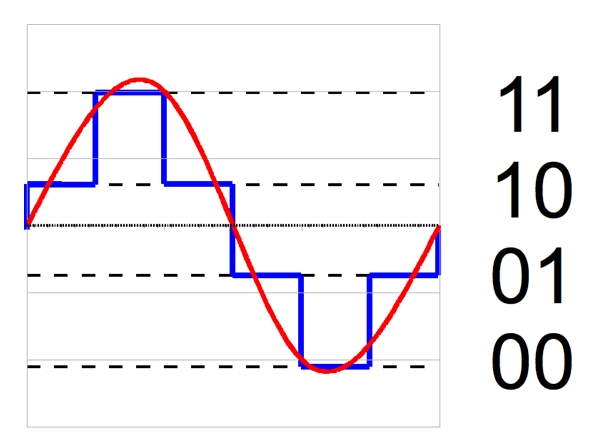
This illustration shows the quantization of an analog to digital signal. This happens when an analog signal (red) is converted to digital (blue) with an A/D converter. Digital processing is just working with the simplified signal (blue) which is not as smooth, natural, or detailed as a real analog signal.
When you are processing real analog signals with analog equalizers, compressors, etc., you are processing/changing the flow of millions of electrons (particles transferring electric signal in cables – in physics/real world). When you are doing the same processing in the digital world you are just doing approximate mathematical calculations with a lot of inaccuracies. The resulting sound is flat, digital and squared (similar to the quantized signal pictured above).
Equalization
During the mastering process you are often using equalizers. Digital EQs are perfect for cutting but for boosting they often sound really harsh, unpleasant, full of artifacts and digital distortion, especially in the higher frequencies. More boost = more harshness and digital sound. This is often very audible at high volumes especially after use of a limiter after eq in mastering.
We can compare/liken equalizers to zooming. With an analog magnifying lens or digital zoom/lens you are magnifying some object. With an equalizer boosting you are magnifying some frequencies, for example to boost some instruments in an overall mix. In reality you are magnifying the amplitude of a selected frequency range.
I don’t want to overload you with tens of pages of technical facts why exactly analog equalization sounds much better but will probably write another technical article just about this problem. There is big difference between working with real signals (electrons) and mathematical calculations of computer digits. I will, just for illustration, show you the difference between analog zoom and digital zoom of visual information:
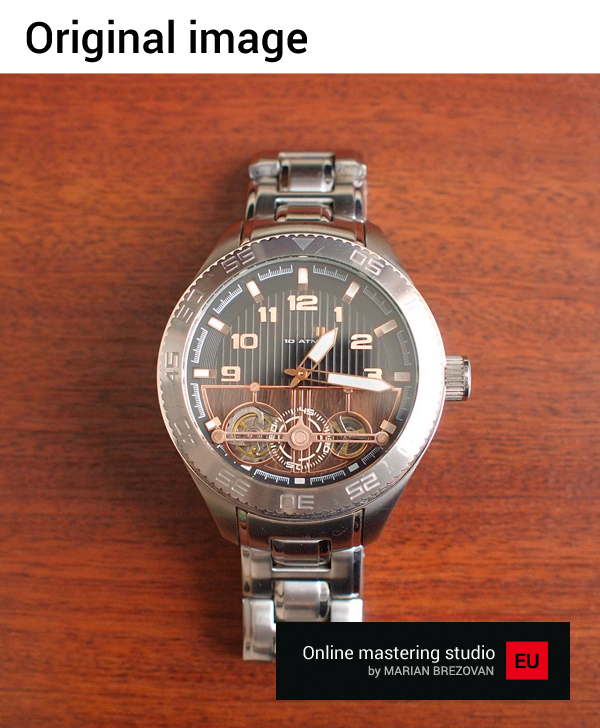
Analog zoom – magnifying lens (Similar to ANALOG EQUALIZER BOOST – you are zooming real atoms of a real object. With an analog equalizer you are boosting (virtually zooming) some frequency range of a real signal – real electrons (physical particles of electric signal).
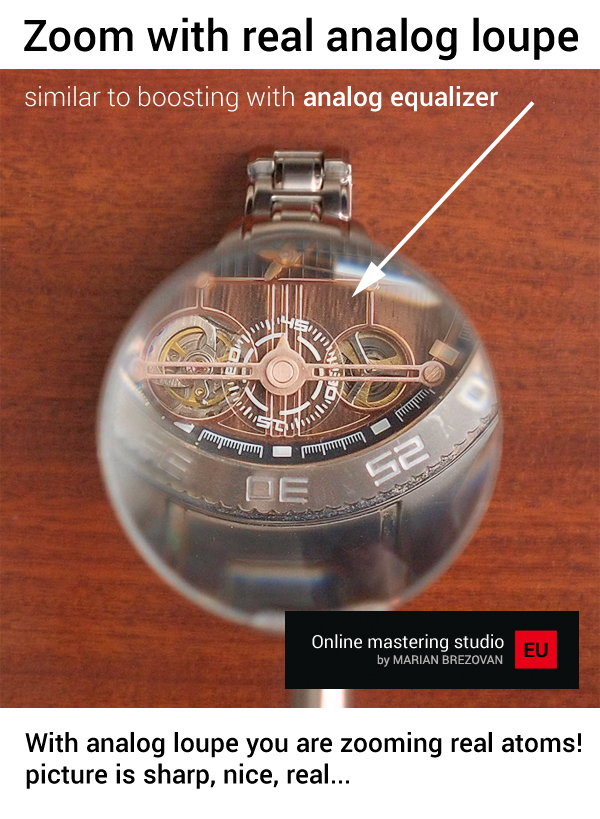
You don’t see any artifacts – the picture is clear, nice, sharp with perfect resolution, real…
you can zoom more and more without any loss of quality (depends on loupe/microscope used)
Digital zoom – (artifacts) pixels instead of clear picture (loss of quality)
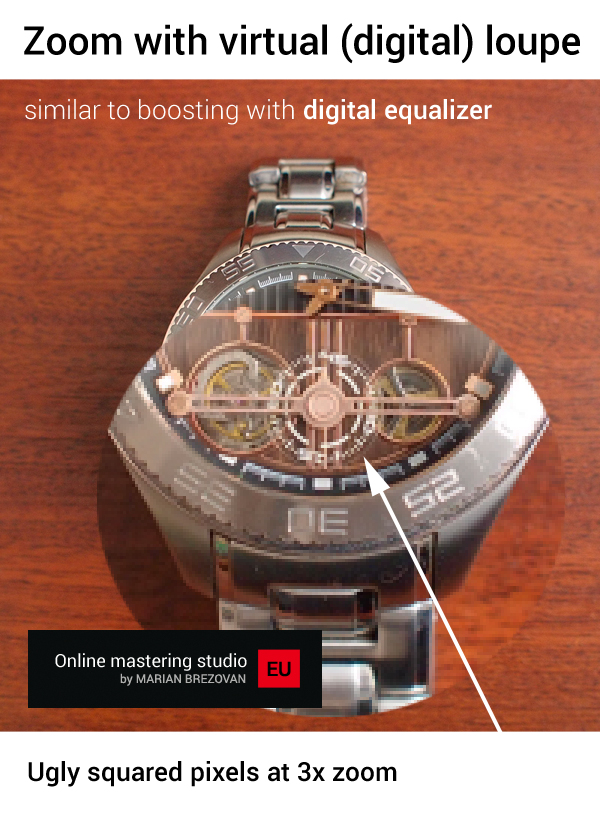
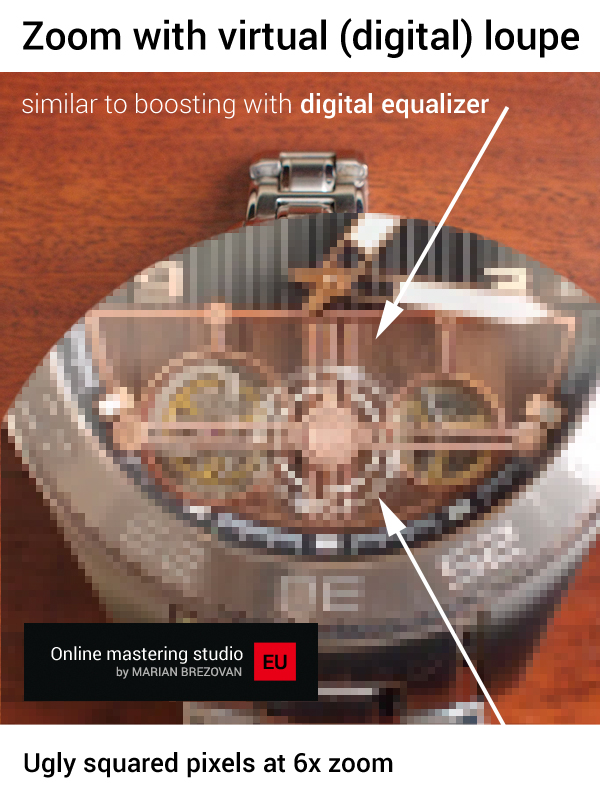
With a digital picture (same as with digital audio signal) you have limited resolution, limited amount of digital information. When you are processing or boosting some part of digital information (digital audio signal or digital picture/photo) you are working with missing information – so the computer calculates just an approximate result. When boosting/zooming a real object (similar to a real analog signal) with an analog loupe/microscope (similar to an analog equalizer) you are working with real analog signals – for example, reflections of electromagnetic waves (light) from real objects – with very high resolution and information represented by quadrillions of photons. When this signal is boosted you are getting virtually no loss of quality/damage to the signal. When you boost/zoom a digital source (audio, photo) with a digital loupe/zoom (similar to a digital equalizer) you get ugly squared pixels in the case of a picture/photo (loss of quality) and squared ugly bass and harsh, distorted, ugly treble and transients in the case of boosting a digital signal.
Why does this happen? This picture explains everything:
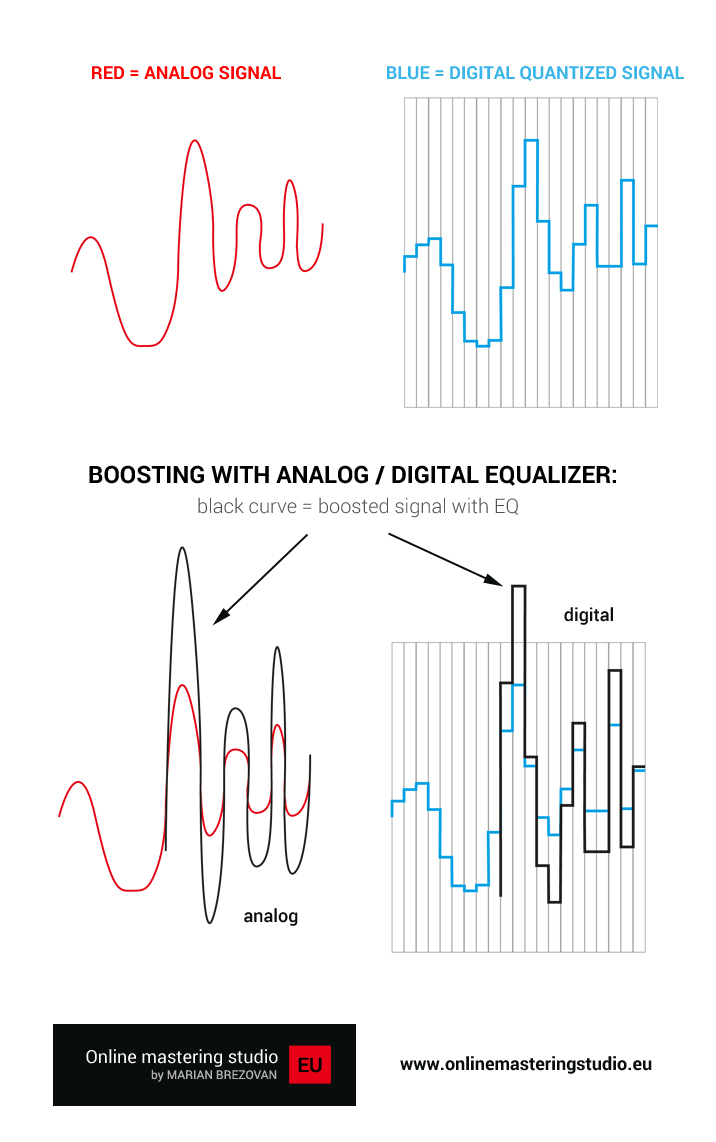
Sure analog vs. digital processing of audio compared to photo processing is a little bit different but still similar. Boosting frequencies during mastering with digital equalizers can bring similar results and problems as digital zoom of digital photos. You often need to boost high frequencies and bass frequencies in mastering which are most sensitive for processing. The more you boost the more problems – artifacts, squared digital sharp sound – because of the bigger differences between numbers representing individual processed samples.
Try this simple test: boost mid and high frequencies with an analog and digital equalizer then apply a high level of limiting with a good quality mastering limiter. Listen to the result on high quality headphones or speakers and compare.
There are worse, good, and much better digital equalizers. It depends on the style of processing, algorithms used, etc. Usually the best digital equalizers are those using specialized chips designed for DSP (Motorola/Sharc chips) used in some DSP cards and hardware like Weiss, TC Electronic, etc. They are usually working with different bit depth, resolution, inner architecture, algorithms and processing than basic software VST EQs because computers use universal chips while these tools use chips designed only for digital sound processing.
Distortion/higher harmonics
Compressors, limiters (or any gain reduction) and so-called colored (virtual analog) digital equalizers are creating distortion. Distortion creates higher harmonics. Higher harmonics are multiples of fundamental frequencies. They are quiet but audible. Many musicians call them “color”. They can enrich/enhance music and add vibrancy but there is difference between real analog color/harmonics and digital harmonics. Digital harmonics are usually full of ugly/harsh digital artifacts when you are processing difficult complex signals like stereo bus masters. This happens because harmonics are created from the quantized signal which is not often smooth and round like analog but gritty and consists just of samples. There is another aspect as previously said. Higher harmonics are multiples of fundamental frequencies., If a 16 kHz frequency has higher harmonics they are = 32kHz (2nd harmonics), 48khz (3rd harmonics), etc.. But CD audio is limited up to 44.1 kHz sampling rate so what happens if these higher harmonics are generated in the digital world? Any signals above 22.05kHz (half the sample rate) is usually returned back as ugly digital artifacts known as “aliasing”! This does not happen in the analog world.
Compressors, soft clippers, saturators.
Digital compressors will probably never have the same quality and transparency as analog ones. They seem to be close, but when you apply the same volume with limiters and compare to analog you can hear a big difference. Digital compressors produce distortion – digital distortion – that is unpleasant for our ears/brain. You can hear this distortion mainly when you use higher volume levels on a master that has been processed with a digital limiter. At professional mastering studios vacuum tubes and lot of soft clipping/saturation is used to achieve high volumes. Digital tools are trying to imitate this behavior but always sound harsh, squared and artificial. Yes, oversampling can be helpful but it always sounds harsh and artificial when used on complex, difficult signals like the stereo master bus because of reasons mentioned in the previous part of this article. Real analog saturation using vacuum tubes, analog tapes, transformers, etc., will always produce different, more pleasant results because you are saturating real signals where the energy of real electrons is transformed, while digital works only with samples/numbers. It is like computer games where you see a virtual 3D simulation but with lot of defects and artifacts like polygon simplification, lowered texture resolution for better performance, etc., not reality. Maybe in year 2300 virtual reality will have the visual quality of a real environment but for now digital audio processing and 3D graphics is just mathematical simulation of reality, and real is real (and much better).
Negative results of digital mastering is audible on acoustic music that was mastered only digital (ITB) but very audible and unpleasant on music that was completely produced digitally – digital dance music of any genre. Why? Because when you are doing digital mastering of acoustic recordings you are doing mathematical calculations of, let’s say, realistic (acoustic) input signals (real natural music). But when you are mastering digitally produced music you are doing mathematical calculations of mathematical produced music so all negative facts like harshness and distortion are even more audible and multiplied. This happens because many samples are periodically repeated – like a kick drum that is always the same 4/4 sample, hihat is always the same sample, bassline is always same, etc., so higher harmonics produced by digital VST plugins of these periodically repeated samples (which are often synthetic) sound even more artificial, distorted and unpleasant.
All defects of digital processing are multiplied with volume boosting by a limiter, and later by amplifiers of good quality speakers and big PA systems. So together it sounds bad.
Listen to digital vs analog mastered electronic dance music and compare on high quality speakers/headphones:
– Transients and trebles sound harsh, crisp, sharp, unpleasant, digital, plastic, full of artifacts with digital mastering at high volumes.
– Sound is flat 2D with digital mastering, instruments seem to be too glued together. While analog mastering sounds 3D (three dimensional), natural, organic, full, fat, big, instruments and channels are well separated – mix has space, transparency.
– Bass is usually flat, squared with digital sound and distortion while analog saturation produces round, fat, juicy bass.
– Mid-Treble range is full of artifacts, distortion and harshness with digital mastering (higher harmonics and artifacts are compounded mainly in this frequency spectrum).
– Overall sound is more digital, hard, distorted and squared at high RMS volume levels compared to analog which always sound rounder, more pleasant and natural.
Of course sometimes the precision of digital equipment is very good and the combination of analog and digital works very well. We use digital equipment for surgical, precise changes, filtering and special processing, but overall I can say I’m trying to avoid digital VST plug-ins and, rather, use specialized digital DSP hardware. I don’t prefer to use digital processing for adding anything (boosting frequencies, color) and always use digital just for reducing (cutting volume/frequencies) during mastering.
ARTISTIC POINT OF VIEW:
The human ear/brain is adjusted to real acoustic signals. For thousands of years of evolution our ears and brain have listened to real acoustic (analog) sounds – real drums, real guitars, didgeridoos, etc. Digital sounds or digitally processed acoustic sounds are often not pleasant or natural for the brain – they must be shaped (for example rounder transients) similar to real acoustic signals in order to make them pleasant for listeners.
We played analog and digitally mastered songs through a big, loud PA system to group of about 20 people at a club as a test.
Small distortion, unpleasant frequencies and harshness in sound is multiplied many times when music is reproduced by a big PA system in a club, festival or hi-end audiophile hi-fi. So if computer mastering doesn’t sound good on small speakers/monitors, on a big PA it will be a disaster!
You know what 20 out of those 20 people chose as best? Analog mastering! Their second choice was digital mastering made on digital hardware. Their last choice (worst sounding) was the master made with digital VST plug-ins only.
We also did another test where we generated a bit of distortion in hard electronic music (Drum and Bass, EDM, Hardcore, Psytrance) real time in the club with analog limiters, digital limiters, analog and digital saturation. (This is a common scenario because club PA systems typically have limiters in their racks and DJs are often playing RED at mixpults, etc.).
Just as when we compared analog to digital limiting of songs on the PA system, people chose analog as better.
When we played analog masters at very high volume people told us it was full of energy and making them good feeling forcing them to dance.
When we played a digital VST master at very high volume people told us it was unpleasant for them and, after longer listening, made them feel angry and anxious –like when they hear unpleasant industrial noise like brushing metal, whistle of old train breaks, jackhammers, drills, etc. This is because trebles and transients were sharp, digital, cold, and bass was more squared; beats were more distorted, mid-trebles full of digital artifacts. All of this is unpleasant for the brain.
While one can say it is based on personal taste, there are many studies including our own tests that show people prefer a warmer sound over a cold one, analog saturation over digital, round transients over sharp transients, and analog higher harmonics over digitally produced harsh harmonics with transients. The human brain listened to acoustic, real sounds for thousands of years during evolution and is adapted for real signals rather than digital simulations. Some unpleasant digital ills (digital distortion, artifacts, sharp digital transients, harsh mids and trebles) can also produce virtual pain/anxiety/disgusting feeling in people when listening for longer periods of time on very loud PA systems such as clubs and festivals.
BIOLOGICAL / SPIRITUAL / HISTORICAL / THEORETICAL POINT OF VIEW:
This article is mainly about mastering of electronic produced music and why it should be mastered using analog processing but let’s speak about it also from a different point of view. We love electronic dance music, but we must agree that real acoustic music is much more pleasant for the ears/brain. Real music is produced with real instruments. The human brain adapted to real acoustic music during thousands of years of evolution. That is fact. Real analog instruments (guitar, drums, didgeridoos) do not produce distortion, harshness, artifacts – it is produced only by recorded and reproduced music (also big PA systems, analog amplifiers produce distortion). Natural frequencies, vibrations, melodies are simply more pleasant to the brain. Digital dance floor music is more and more popular because of two facts: every culture had rituals, shamanic rituals where people were dancing and going to trance/hypnotic states of consciousness. Modern society forgets these rituals but people still need a bit of spirituality. We have many traditions deep-rooted in our DNA (some of our ancestors participated in these shamanic rituals for hundreds of years as, for sure, we all have ancestors in Africa). Modern people transformed these rituals into modern dance floor raves. This is why dance floor music is more and more popular in modern society – people are far from natural living in nature, spirituality, rituals – but they still feel they need it. Modern dance floor music is virtually the same as old shamanic drum rhythms, just more modern, more powerful and energetic. Another reason why people love electronic dance music is the fact that people like progress, discovering new things, new sounds. Acoustic music sounds always the same. Electronic music is always offering new sounds, experiments, progress. The listener can listen to things he never heard before and this is magic for many people.
But as previously said, the brain is adapted to real acoustic music, real vibrations, not synthetic digitally produced sounds. Shamanic rituals used rhythmic, hypnotic, repetitive drumming – rhythms that seemed to be same for long periods of time but they were not. If you listen carefully the rhythm is similar but there are always some little variations. People are not robots so there are some deviations from the rhythm. Human drumming is not always 140 BPM and it varies from 139-141 for example (only computers play drums rhythmically 100% precise). In addition, every shot of human-played drums sounds a little bit different (different volume, transient, frequency spectrum, panning). So real drumming is constantly changing and different every second. Do your own test: play computer simulated acoustic drums made of recorded samples of real drums and compare with real drums played by a human. Play this test for people and they will choose real drums as much better and interesting and computer drums as more boring. Computer music is producing beats that are always the same, same rhythm, same frequency, same kick drum, hihat, clap, etc., but the brain prefers variations, real rhythm, nonlinearities, changing of frequencies, transients and other miniature changes of sound in time. If you process digital dance floor music with analog equipment repetitive computer music will be changed a little bit as it is transformed to analog (real signal). Even just using an analog compressor changes the beat a little bit – it makes every sample sound a bit different – kick drums get volume variations, hihats get volume, transient and frequency variations. When the signal is converted to analog and processed with analog equipment like equalizers, soft saturation and vacuum tubes it becomes realistic, nonlinear and more similar to real acoustic signals which are constantly changing. When you process beats (drum, hihat, clap) with digital tools it always sounds the same – robotic, linear, plastic, unnatural, mathematical and often harsh. Simple digital processors cannot behave like real analog ones. They work with numbers not real physics/physical signals. Analog processing reshapes cold digital beats to realistic natural sounding beats. The volume and frequency of every kick, hihat and clap is changed every second because the compressor changes the signal based on the input signal. Electrons in vacuum tubes are working a little bit different every millisecond. Every millisecond a different amount of electrons is emitted and received in a vacuum tube so the tube sounds significantly different in time. A warmer tube is different still and produces a warmer, rounder and more pleasant sound than a cold tube. Analog saturators and equalizers always have variations in sound because of instability of electronic components used (capacitors, resistors, opamps, vacuum tubes, transformers). In analog mastering the digital mathematical signal is transformed from digits to real electrons and then processed. So while it may sound similar there are constant changes of volume, frequency and other nonlinearities produced, changing a cold, mathematically precise signal to a signal which is similar to real acoustic vibrations. The simple brain loves these constant variations! This is why digital synthesizers are trying to simulate these nonlinearities of real old school analog synthesizers (changing volume of components, frequencies in time, detuning of oscillators in time, analog noise) because a natural, constantly changing, nonlinear signal is more pleasant for the brain. Analog processing can make robotic digital music more realistic. And while this is often perceived subliminally it affects the overall impression and feeling from music. More pleasant music/sound = more joy, more joy means people will remember your music and it can become a famous bestseller!
LISTEN TO: ANALOG vs. DIGITAL MASTERING EXAMPLES (wav files)
Author of article is MARIAN “BREZEKHIEL” BREZOVAN from mix/mastering studio ONLINEMASTERINGSTUDIO.EU
Marian has more than 15 years of experiences with music production (started with prehistoric software Fasttracker / Rebirth RB-338) mix and mastering. Marian was co-founder of A.D. mastering studios and is active as DSP computer programmer of VST plug-ins for more than 9 years (worked with various software companies worldwide as chief of development). Article corrector/editor was Jeff Rippe from Raising Jake Studios, California, USA.
Copyright Marian Brezovan / Onlinemasteringstudio.eu 2017. All Rights reserved.
